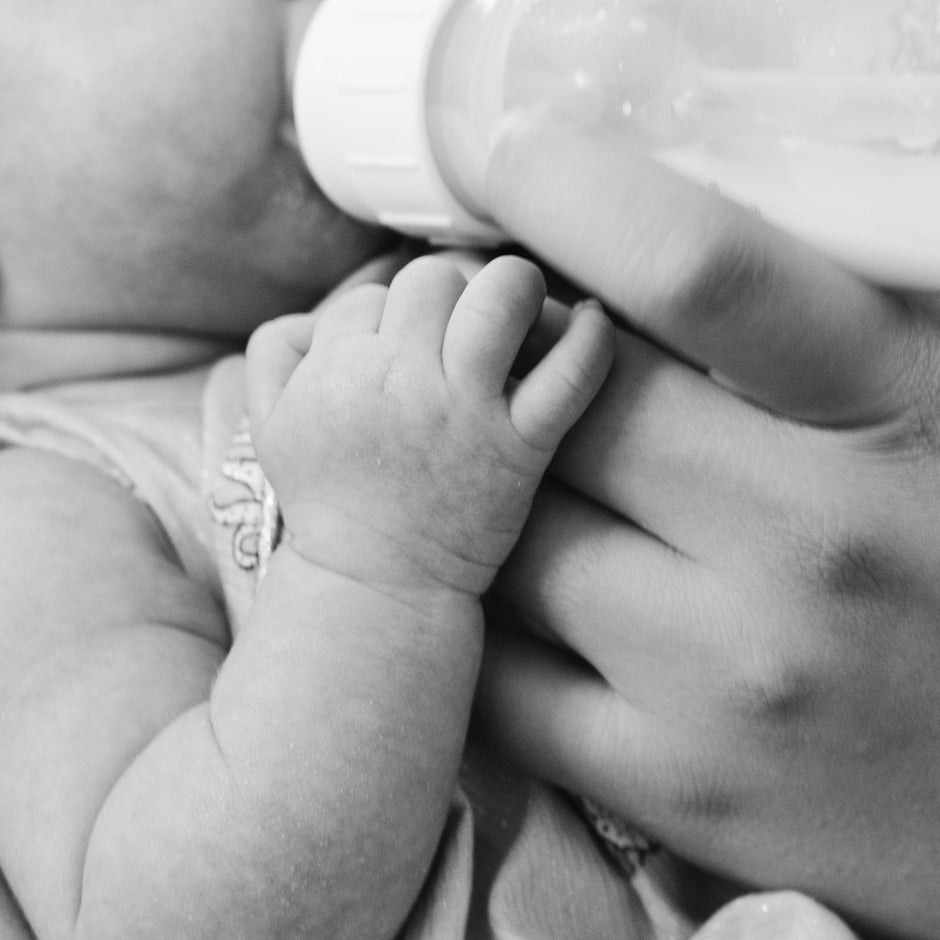Everything About the Stool of Bottle-Fed Babies
Updated on:
Photo by Kelly Sikkema on Unsplash
The contents of a diaper from a baby who is bottle-fed look different from those of a breastfed baby. We know this from our own experience—the type of food naturally shapes bowel movements. Nevertheless, this topic is very much on parents’ minds. Is my baby’s stool normal?
Bottle-fed babies have different stools than breastfed babies
What does the stool of bottle-fed babies look like? The stool of bottle-fed babies is mushier than that of breastfed babies. Sometimes it can even be formed. The color of the stool ranges from pale yellow to dark green—the color palette is broad. The smell is also often stronger compared to breastfed babies.
Are you breastfeeding your baby? We’ve also covered the color and consistency of breast milk stool on our blog.
All about the stool of bottle-fed babies
Your baby is going through an incredible development. After birth, the digestive system begins to work, but it is not yet fully matured. Additionally, it can happen that your baby swallows too much air while drinking, which can lead to bloating.
However, your baby is becoming more accustomed to this new world day by day—and this also applies to the digestive system. Certain processes still need to develop.
Digestive Logbook for Bottle-fed Babies
Here you can record your baby's meals, bowel movements, and any special observations. This helps you recognize patterns and better understand the development of digestion. The data is only stored locally in your browser.
Your Entries
No entries yet.

Photo by @isabelplett
The digestive system changes
All parents are familiar with growth spurts, and these have a major impact on digestion. This is true not only for newborns or children, but also for adults. Factors such as stress or travel can also sometimes cause changes in our own digestive system.
So it is completely normal that your child’s digestion especially changes continuously during the first year. The contents of the diaper will keep surprising you during this time.
Color and consistency of stool in bottle-fed babies
After birth, babies pass meconium—whether a child is breastfed or bottle-fed has no effect on this. Subsequently, the stool changes, shaped by the type of nutrition.
For bottle-fed babies, the color ranges from light yellow to ochre to clay brown. However, this can also vary: sometimes the stool is dark green in color.
The consistency also differs from that of breastfed babies’ stools. While breastfed babies often have a more liquid stool, bottle-fed babies have stools that are usually mushier or even already formed.
What does green stool mean in bottle-fed babies?
There can be different reasons why a baby has green stool—but they are usually not a cause for concern.
Bottle-fed babies have green stool more often than breastfed babies. The discoloration can come from hydrolyzed protein in HA formula or from added iron in infant formula.
Is it normal for a baby's stool to smell?
The smell of stool depends on the type of nutrition. The meconium passed after birth has almost no odor. Breast milk stool smells very mild.
In bottle-fed babies, however, it often smells much stronger and can even be perceived as pungent.
How often should a bottle-fed baby have a bowel movement?
Bottle-fed babies pass stool several times a day or at least every other day. However, this is only a guideline—after all, every baby develops a bit differently. In general, bottle-fed babies have more frequent bowel movements than breastfed babies.
The number of bowel movements decreases over time
The frequency of bowel movements is not only individual for each child but also changes over time. In the beginning, there may be a bowel movement after every meal. The older your child gets, the less frequent these movements become.
This is due to development: about three to four weeks after birth, the intestine matures and can process more nutrients. The result is firmer and less frequent stools.

Photo by PublicDomainPictures from Pixabay
When digestion causes discomfort
Digestive issues in infants are not uncommon. As parents, it is difficult to bear when your own baby is in pain. You can support your baby; however, much of it is simply developmental and therefore harmless.
Constipation in infants
Constipation can occur repeatedly in newborns. If the stool is dry and hard for an extended period, this may indicate constipation.
Additives to soften the stool are not necessary as long as the baby is still drinking formula milk. In most cases, special formula is not needed either. When you start introducing solid foods, fiber-rich foods will support digestion. However, if constipation becomes excessive, your child suffers from severe pain, or there is even blood in the stool, it is advisable to consult a pediatrician.
Abdominal massage for constipation and bloating
An abdominal massage can work wonders for constipation: Gently massage your baby's tummy around the navel with one finger. This movement helps the intestines get moving and relieves constipation.
Alternatively, warmth is also a good option. Whether a cherry pit pillow or a hot water bottle—heat supports digestion. This is not only helpful for constipation; it can also reduce bloating. Always make sure that the temperature is appropriate and your child feels comfortable. Especially bottle-fed babies often swallow too much air while drinking at first, which then collects in the stomach. A burp after feeding helps release the air again.
Hard and dry stool
Does your baby have to strain a lot and cry during a bowel movement? That is not at all unusual. For a newborn, pushing out a bowel movement is actually not so easy. This is due to processes in digestion that are not yet perfectly coordinated. On the other hand, watery stool does not always mean diarrhea.
Creamy-firm stool is normal for bottle-fed babies. However, sometimes it can also be a bit more liquid from time to time.

Photo by @madame.vio
What is considered diarrhea?
Diarrhea is defined as your baby having more than five liquid stools with an unusual amount, color, or smell within 24 hours. If your child usually has infrequent bowel movements, even three stools in 24 hours may indicate diarrhea.
The reason for these varying guidelines is simple: babies are incredibly different and develop at their own pace.
In most cases, diarrhea is harmless
Watery stool does not necessarily mean there is an infection. Other changes in the baby’s life can disrupt the digestive system. Just like constipation, diarrhea is often a normal part of the first year of life—but it is mostly absolutely harmless.
As parents, we can usually rely on our intuition and our bond with the baby.
Three-month colic
Three-month colic refers to persistent, recurring abdominal pain in infants between about two weeks and four months old. The symptoms can vary, but typically they occur in the late afternoon or evening hours.
Symptoms of three-month colic include bloating, cramps, restlessness, prolonged crying, and difficulty falling asleep.
These are the causes of three-month colic
The exact causes of three-month colic are not fully understood, and it is not clear why they occur more frequently in bottle-fed babies than in breastfed babies. Experts believe there are several factors that contribute to the development of colic:
-
Immature digestive systems:
In newborns and young infants, the digestive system is not yet fully matured. Therefore, it may take longer for food to be digested, which can lead to bloating and stomach pain. -
Sensitivity to ingredients:
Some babies may be more sensitive to certain ingredients in formula, which can cause digestive problems and colic. -
Swallowing air:
If babies swallow air while feeding, this can lead to bloating and discomfort. -
General restlessness:
Some babies are naturally more restless and respond more sensitively to changes in their environment, which can cause colic-like symptoms.
It is important to note that three-month colic usually subsides on its own after a few weeks. Although three-month colic can be very stressful for parents, it is normally harmless and does not have any long-term effects on the growth or health of the child.
What helps with three-month colic
As with constipation and bloating, abdominal massages and warmth are helpful here. Especially “cycling” can help. For this, lay your baby on their back, bend their knees, and gently press them alternately toward their tummy. The use of fennel tea or similar remedies is not recommended before your baby is ready for solid food. Even later, tea should not be a regular drink as it is intended mainly for medicinal purposes. Babies also often feel safer and more soothed when they are rocked or carried. Rock your baby in a swing or carrier to help them relax.
A change in position can provide relief: Hold your baby upright while feeding to reduce pressure on the stomach.

Photo by @isabelplett
What should I keep in mind when diapering my bottle-fed baby?
Judes cloth diapers can be used right from your baby’s first day of life. Whether you breastfeed or bottle-feed your baby makes no difference when diapering. As long as your baby is not eating solid foods, their stool remains completely water-soluble.
Hygienic and sustainable diapering with Judes cloth diapers
To start, all you need is an outer diaper and an inner diaper. The Poo Paper (our name for the diaper liner at Judes) can (for now) be left out. However, some parents still use it to protect the inner diaper. It sits as the top layer in the diaper and catches the stool. Afterwards, you can hygienically dispose of both.
If your baby’s diaper is full, put it in the breathable diaper bag. After three to four days, this bag goes into the washing machine, where it empties itself automatically thanks to a zipper at the bottom. You can read more about washing cloth diapers on our blog.
This is what makes diapering with Judes cloth diapers so uncomplicated. Instead of piling up disposable diapers in the trash, you have a full diaper bag that goes into the washing machine.
Conclusion
Our digestive system changes significantly after birth—especially during the first year, a lot happens in your baby's tummy. This also affects your baby's stool: color, consistency, smell, and quantity all vary greatly. The color shades range from pale yellow to clay-colored to dark green. The stool of bottle-fed babies smells stronger compared to that of breastfed babies.
Bottle-fed babies usually have less frequent bowel movements than breastfed babies. As a rule of thumb: several times a day up to once every two days is normal. Their stool is firmer than that of breastfed babies. A creamy consistency is typical, but the stool can also be formed already.
It is common for your baby to experience constipation or bloating. While this may be unpleasant, it is part of development. Gentle abdominal massages and warmth help your baby.
Trust your intuition
As parents, we can trust our intuition. No one knows your child better than you do—you usually sense what your child needs.
Still, it’s normal to feel uncertain when things change. Always keep in mind while diapering that your baby is in the midst of development. That, along with external factors, influences our digestion—whether as a child or an adult.

